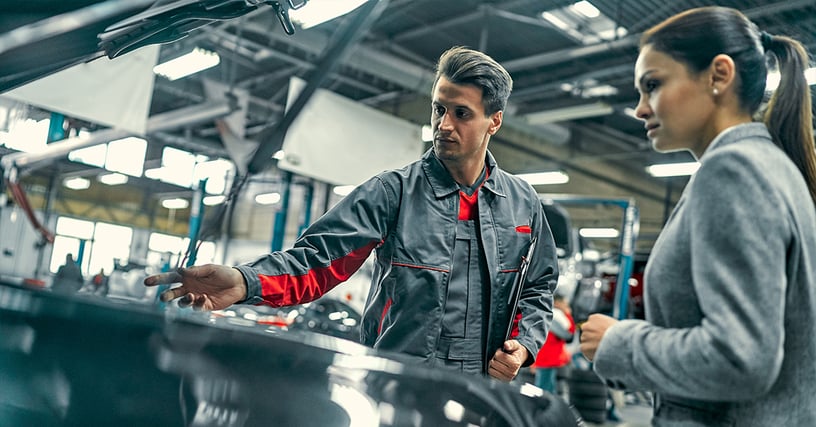As EVs, software, and D2C reshape the road ahead, automakers must evolve beyond machines and build connected, customer-first experiences.

The New Rules of the Road
The automotive industry isn’t just shifting gears anymore—it’s changing its engine entirely.
From electric vehicles and over-the-air updates to D2C sales and app-led experiences, the future of mobility is unfolding now. But here’s the tension: most auto OEMs are still wired for a world that doesn’t exist anymore. Internal combustion, quarterly dealership incentives, and mass-market playbooks aren’t built for a digital-first, experience-led, and software-powered era.
Consumers aren’t waiting. They expect intuitive apps, real-time updates, seamless test drives, personalized financing, and instant trade-ins. They want the car-buying experience to feel more like Apple than a local dealership.
Automakers must now solve for more than just powertrains. They must rethink every part of the experience, from discovery to delivery to daily use. The road ahead is about both machines and mobility ecosystems.
Disruptions Driving the Auto Rebuild
The transformation in the automotive industry is structural. Let’s discuss three seismic shifts every automaker must solve for.
EV demand is surging, and so are expectations
According to BNEF, electric vehicles (EVs) are becoming a significant force in the global automotive market, and EV sales are forecast to hit 30 million by 2027. Electrification has gone mainstream. What was once a future bet is now a baseline, and EV buyers are bringing a new playbook with them. They expect more than just range or rebates. They demand a complete digital experience: intuitive app interfaces, connected services, charging ecosystems, and premium support throughout the ownership journey. Automakers must build not just electric cars, but end-to-end electric experiences, seamlessly integrated, constantly improving, and emotionally resonant.
Distribution is going D2C, and dealerships must evolve
The traditional dealership model is under pressure. From online configurators to home delivery and trade-in automation, the consumer journey is shifting to digital-first, direct-to-consumer (D2C) experiences. That doesn’t mean showrooms are dead, but they must become experiential, consultative, and tech-enabled to stay relevant. The future will be hybrid: digital discovery, virtual validation, and physical immersion. Brands must own the relationship, not just the transaction.
Cars are now software, and consumers want them personalized
The modern car is a rolling operating system. Over-the-air updates, real-time diagnostics, adaptive infotainment, and AI-driven personalization are no longer “nice to have”; they’re central to competitive differentiation. Ownership models are evolving too: subscription services, in-car app marketplaces, and micro-services are changing how consumers interact with vehicles. The most valuable asset? Data.
In fact, a recent Salesforce survey reveals that 43% of drivers are willing to trade personal data for advanced driver personalization. The brands that leverage data to personalize at scale—from seat settings to predictive maintenance—will define loyalty in the next decade.
Connected Experiences Start With Connected Data
64% of enterprises don’t have strong communication channels in place with suppliers, according to a survey by HICX. But as vehicles become more intelligent, the infrastructure around them must be just as smart. Cloud connectivity, real-time diagnostics, and predictive analytics are redefining how automakers understand both the car and the customer. From alerting owners about tire pressure to personalizing in-car experiences or streamlining service visits, data is the foundation.
To build truly differentiated experiences, automakers must connect the dots, not just under the hood, but across every touchpoint. Yet, fragmented systems remain a major barrier. Legacy tech stacks, siloed dealer data, and disconnected service records make it difficult to deliver seamless customer journeys. As cars generate more data than ever (from location and driving behavior to battery health and infotainment usage), the challenge is no longer data availability, but usability. OEMs must invest in data orchestration, going beyond just data collection, to unlock personalized services, predictive maintenance, and lifetime loyalty.
From Car Sellers to Experience Makers
The most successful automakers today are not thinking like manufacturers. They are thinking like mobility tech companies, with agility, data fluency, and obsession with the customer journey. Let’s explore the strategic imperatives shaping the next-generation strategy for the automotive industry.
- Own the customer experience, not just the car: Digitally native buyers don’t want to be sold to. They want to be supported across the lifecycle. This means automakers need to build direct relationships that go far beyond the sale. In practice, this looks like personalized onboarding, mobile-first maintenance, post-sale engagement, and loyalty programs powered by behavior, not just mileage. Digital ownership experiences are the new differentiator.
- Build for both flexibility and flow: Modern vehicle usage is not binary anymore. People lease, subscribe, share, and occasionally even rent out their own cars. The business model has changed. Automakers need to build for flexibility across ownership, usage, and service delivery. That includes supporting subscriptions, usage-based insurance, modular upgrades, and seamless integrations across devices, channels, and mobility platforms.
- Make software the soul of the vehicle: The real engine of modern cars is software. Automakers need to treat their platforms like tech products, with continuous updates, user feedback loops, and performance iteration. Whether it’s predictive diagnostics, personalized infotainment, or remote control features, consumers now expect their car to improve over time. That means integrating real-time data, building agile development cycles, and co-creating with tech partners and platforms.
Together, these imperatives mark a deeper shift—from building cars to designing connected, continuous experiences that evolve with the driver.
The Road Ahead
Automotive brands face a clear choice—evolve or be edged out. Traditional strengths like mechanical engineering or dealership scale are no longer enough. Consumers expect experiences, not just equipment. They want personalization, not presets. They want connection, not complexity.
To thrive in this next chapter, OEMs need to shift from building products to building platforms and replace siloed systems with connected intelligence. Stop retrofitting old models and start engineering new rules!
Modern customers are dynamic users of mobility, and the car is no longer just a vehicle. It is a service, a screen, a software ecosystem, and for many, an extension of their identity. The brands that embrace this evolution and rebuild around it will drive and define what comes next. The road is open. The question is, are you ready to lead it?





